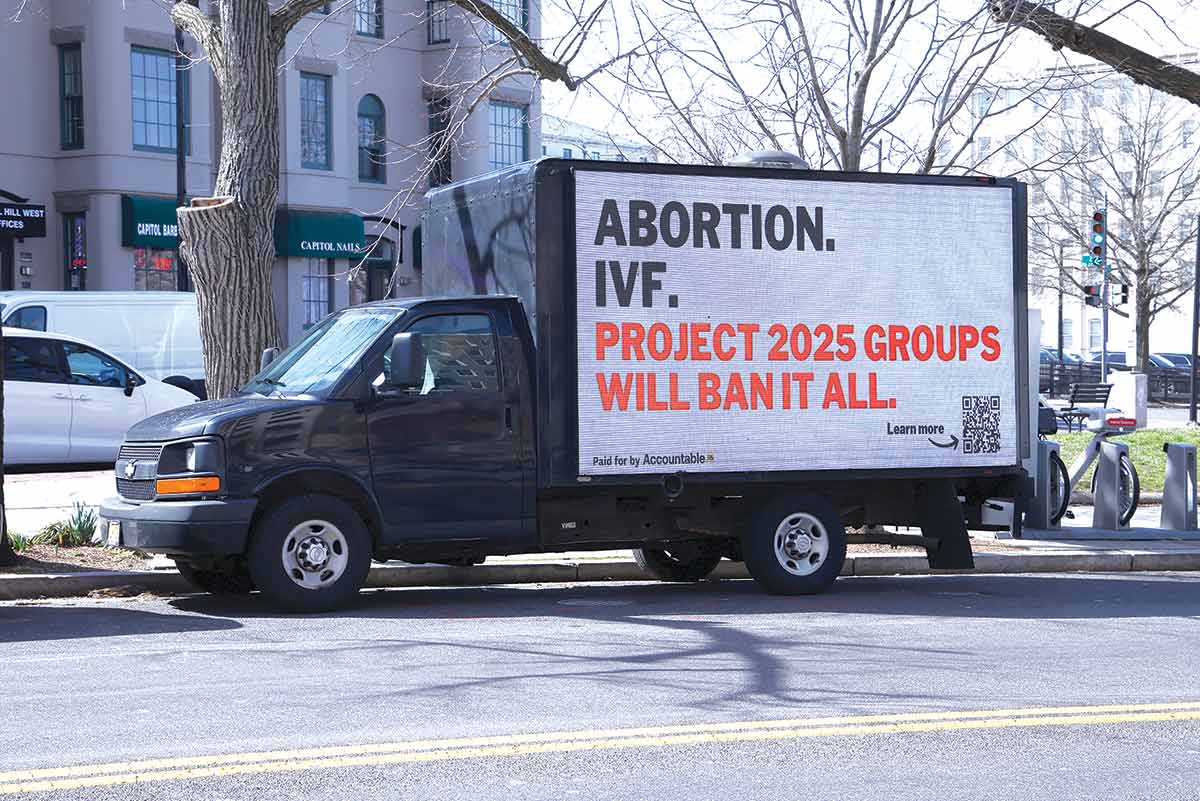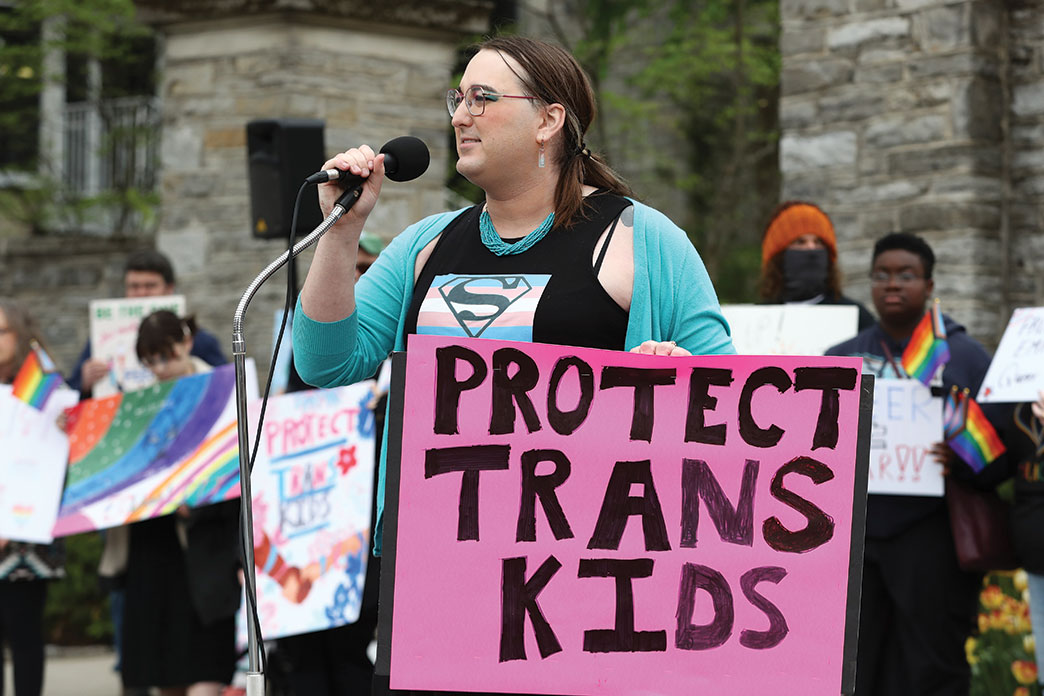What Kind of Damage Will the Supreme Court Inflict This Term?
To understand the ambitions of the conservative majority, look no farther than Project 2025, which was cooked up by some of the same people who engineered the current court.

The Supreme Court returns from its summer vacation on October 7, four weeks and one day before the November 5 general election. The court’s fingerprints (as well as the fingerprints of the wealthy Republican donors who likely paid for some of the justices’ summer vacations) are already all over the upcoming election. Earlier this year, the court ensured Donald Trump a spot on the ballot when it ruled against an attempt to prevent him from running for president because of his participation in an insurrection against the government; then, in July, the Republican justices granted Trump “absolute immunity” for crimes committed as part of his “official duties,” likely ensuring that he will never face accountability for his worst actions. Thanks to these rulings, Trump can legally run for an office he previously attempted to steal.
Given the court’s demonstrated eagerness to put its thumb on the scale for Trump before the election, we can only imagine what it will do to help him after the election. Trump could lose by millions in the popular vote and by 40 votes in the Electoral College, but if he can get just five Supreme Court justices to rule in his favor, none of those votes will matter. The court will invest him with the power to usher in an age of authoritarianism and permanent one-party rule.
Still, even if Kamala Harris does manage to clear every hurdle to the presidency—if she manages to win both the popular vote and the Electoral College, and those votes are honored—it is important to understand that the Supreme Court’s dread work of dismantling democracy and setting back the rights of women, people of color, and the LGBTQ community to the prevailing standards of 1859 will continue apace. The deck has been stacked, and the court’s six conservative justices are not going to let this opportunity go to waste. They have an agenda—a mandate, you could say—and it looks a lot like the one that’s gotten a lot of attention in recent months: Project 2025’s Mandate for Leadership, the conservative plan to take over the federal government and remake the executive branch in a Christofacist image should Trump win.
Project 2025 is the work of the Heritage Foundation. So, in many ways, is the current Supreme Court. Alongside the Federalist Society, the Heritage Foundation has been one of the big players determining which Republicans end up on the nation’s highest court. For over 50 years, it has worked to pack the judiciary with extremist Republican judges in an attempt to wipe out the civil and social progress of the 20th and early 21st centuries. And it has largely succeeded.
This success may help to explain one of the few gaps in the 900-page Project 2025 document: the absence of a detailed section dedicated to the Supreme Court. I believe this is because the fascist blueprint assumes that the court has already been captured. Project 2025 is in motion in the courts, and it will continue to move forward there, with or without Trump in office, because its core tenets are supported by a majority of the Supreme Court’s justices.
This tells us a lot about what we can expect from the court in the future. Over the coming term and the many that follow, we will see Project 2025’s agenda play out in three key areas: the administrative state, environmental regulations, and civil rights.
The dismantling of the administrative state has been a defining obsession for conservatives for decades, and one they’ve come closer and closer to realizing in recent years. At the beginning of the summer, the Supreme Court overturned Chevron deference—the legal doctrine that courts should defer to executive agencies on matters concerning the interpretation of congressional statutes. The ruling calls into question thousands of regulations that have been put forward by those executive agencies. Leonard Leo, the ever-ruthless Svengali of the Federalist Society, has called on Republicans to “flood the zone” with challenges to these regulations, and the lower courts are already weighing a number of cases that seek to punch holes in the regulatory authority of agencies like the Securities and Exchange Commission and the Bureau of Alcohol, Tobacco, Firearms and Explosives (ATF).
Many of these cases might not be ready for Supreme Court review this term, but when it comes to the environment, there are already two cases on the court’s docket that will let the conservative justices fulfill their role as unofficial members of the fossil fuel and chemical industries. In City and County of San Francisco v. Environmental Protection Agency, the Supreme Court will likely decide that its members, not environmental experts, should determine just how much pollution and human filth can be dumped into the ocean. And in Seven County Infrastructure Coalition v. Eagle County, Colorado, the conservatives will likely choose to weaken the role of environmental-impact studies. The National Environmental Policy Act requires agencies to conduct such studies before commencing major projects that will alter the surrounding ecosystem, but conservatives and polluters want to free developers to wreak as much havoc as they want on the environment.
Nor will the court stop at deregulation and environmental abuse. One of Project 2025’s main goals is to reassert and safeguard white supremacy by overturning any law or policy meant to even the playing field. The Supreme Court’s 2023 ruling ending affirmative action was only the beginning for these people. The plan is to take Clarence Thomas’s willful misinterpretation of the 14th Amendment, as articulated in his concurring opinion for Students for Fair Admissions v. Harvard, and weaponize it against any civil rights program they don’t like. Already there are cases making their way through the lower courts of appeal that seek to make race consciousness in hiring unconstitutional. There’s an effort to declare that workplace training on diversity and inclusion creates a “hostile” work environment. And a Trump judge in Texas has ruled the Minority Business Development Act unconstitutional. The Supreme Court hasn’t decided to hear any of these cases yet, but they are likely to do so soon—which means that in the coming months and years, we will almost certainly see the court redefine “civil rights” to mean “for white people and no one else.”

Beyond these kinds of Project 2025–aligned cases, this Supreme Court term will, once again, see the conservative justices make schools dangerous for children but safe for mass shooters, make the country unwelcoming to immigrants from the Global South, and take barbarous positions on the death penalty and send potentially innocent people to die. And notwithstanding their positions on the death penalty, the conservative justices will declare themselves “pro-life” and resume their assault on reproductive rights. Last term, the court punted on two major abortion cases, probably in an attempt to avoid inflaming the issue before the election. But you can bet those cases will be back on the docket after the election.
In FDA v. Alliance for Hippocratic Medicine, the Supreme Court ruled that a group consisting of doctors, a dentist, and several individuals without any medical training or licenses had no standing to sue the Food and Drug Administration over its authorization of the drug mifepristone for use in medication abortions. The court then remanded the case to the Fifth Circuit, to Trump-appointed Judge Matthew Kacsmaryk, who is the one who allowed these assorted randos to sue in the first place. Now Kacsmaryk has given state officials in Idaho, Kansas, and Missouri the right to join the litigation as coplaintiffs, potentially solving the standing problem. The question of whether mifepristone will remain legal is still very much up in the air.
The second case is Moyle v. United States. In late June, the Supreme Court dismissed a case arguing that the Emergency Medical Treatment and Active Labor Act (EMTALA) could not require hospitals to provide abortions when the life or health of the expectant mother is at risk. Once again, it did so on technical grounds—but with a twist. While the court’s decision sidestepped the underlying issues in the case, Justice Amy Coney Barrett’s important concurrence included some advice to forced-birth advocates on how to win in the future: tweak the case to argue that Congress cannot require hospitals to follow EMTALA as a condition of receiving Medicare funds. Should challengers take the hint, that case could be back at the Supreme Court sooner rather than later.
The court has not yet finished slating all of its cases for the term, but its docket is already filled with cases that cover a range of important areas, and this bodes ill for millions of people. Let’s review the worst of the cases we know about so far—and hope that this is the last term we have to suffer an unchecked, unaccountable, Republican supermajority entrenched in lifetime power.

Garland v. VanDerStok
argument date: october 8, 2024
This case will give conservatives on the Supreme Court the chance to legalize “ghost guns.”
A ghost gun is essentially a do-it-yourself gun made from a mishmash of parts sold online or from a self-assembly kit. A seller sends all the parts and instructions to a purchaser, who then puts together the deadly weapon themselves. Because the resulting gun does not have a serial number, the gun is effectively untraceable (hence the “ghost” moniker).
The astute reader might notice that ghost guns allow purchasers to avoid nearly every gun law we have on the books. And that, of course, is the point. Because the gun is delivered disassembled, purchasers do not have to go through background checks and are able to avoid any “red flag” laws that would prevent them from buying a fully assembled firearm from a licensed retailer. You can see the utility of these weapons from the perspective of those who should never be allowed to buy guns.
Defenders of ghost guns say that making a gun from an assembly kit is no different from gunsmithing, which has been legal since before the country’s founding. Indeed, the technical term for this category of weapons is “privately made firearms,” or PMFs, and the conceit is that people are merely buying parts that they are legally allowed to buy and then combining them in ways they are legally allowed to do. The only way they violate the law is if they use their DIY gun illegally—say, by killing their spouse or your children with a gun they could not have bought but now own because they made it themselves.
This argument sounds like one a terrorist might make. You can search on the Internet and pretty quickly find instructions on how to make your own bomb. You can also go to a hardware store and legally buy everything you need to follow the bomb-making recipe. You might not technically violate the law… until you rig the bomb to blow up. And yet, I believe that if Home Depot or Dick’s Sporting Goods had a “Bomb-Making” section tucked neatly behind the aisle for “Shrapnel & Incendiaries” and staffed by the Unabomber, the government would put a stop to it. If Home Depot mailed all the bomb-making materials to your house, its lawyers would probably make the company stop based on the threat of legal liability alone. (At least I hope they would: The Home Depots in Texas could call that section the “Anti-Immigrant” aisle, and then Ted Cruz would defend it with his life.)
In 2022, the ATF attempted to put a stop to ghost guns by promulgating a 98-page rule that expanded the definition of “firearms” under the 1968 Gun Control Act to include them. The rule change mandated that the sellers of these weapons had to comply with all the laws (including background checks, transfer records, and serial numbers) that other gun manufacturers must respect.
Predictably, that change triggered the lawsuit that has now reached the Supreme Court. Ghost gun sellers (along with a pair of owners and several ammosexual rights groups) argued that the new rule exceeds the ATF’s authority and violates the Administrative Procedures Act (which addresses how agencies create new regulations), while also making all the usual ammosexual arguments about the Second Amendment and freedom and America and the inviolable primordial need to kill whatever is bothering you.
You’ve heard it all before. And, unfortunately, you also know how the court’s bloodthirsty conservatives are going to rule on this case. That’s because the Supreme Court weighed in on a similar issue just last term. In Garland v. Cargill, the court’s conservatives overturned a ban on bump stocks, which are devices that turn a semiautomatic weapon into what is functionally a fully automatic machine gun. The court ruled that the ATF exceeded its authority, and to get there, the justices engaged in a long discussion about the technical specifications of bump stocks, while largely ignoring what bump stocks allow a shooter to do.
We can expect the conservatives to do the same thing in VanDerStok. They’ll focus on the technical definitions of “frame” and “receiver” and determine that modern ghost guns do not function like guns did in 1968—instead of considering the fact that ghost guns allow their users to do exactly the same thing as guns did in 1968: kill people. It is the killing function that necessitates regulation, not the mechanical interplay of the bits and bobbles. But it’s that killing function that conservative jurists have decided to ignore.
This case will likely be decided 6–3, along partisan lines, with the conservative justices enabling more violence. The best hope to keep our children and our society safe from DIY guns is to vote Democrats into control of both chambers of Congress and have them pass a new law banning ghost guns and bump stocks.

United States v. Skrmetti
argument date: TBD
In 2023, Tennessee banned gender-affirming care for people under the age of 18. The ban outlawed hormone therapy, puberty blockers, and gender-transition surgeries for minors—regardless of whether parents had knowledge of the care and had given their consent. Tennessee might as well be called “Hogwarts” given its legal hostility to the transgender community. More than a dozen states have since implemented similar bans.
Tennessee was sued by three trans adolescents and their parents on the grounds that the state violated their equal protection rights; eventually, the Biden administration joined the suit on their behalf. This case pits parents’ rights—specifically their right to get their kids the medical care they deem to be in the children’s best interest—against the state’s right to prohibit medical care simply because that care makes conservatives angry and liable to throw away their cans of Bud Light.
The equal protection arguments raised by the parents are compelling. The drugs and therapies in question are readily given to adolescents whose gender identity matches the one they were assigned at birth; boys born with male anatomy are allowed to have access to testosterone boosters, for instance, but trans boys are not. The Biden administration says the Tennessee law targets transgender kids in an effort to “enforce conformity.” For their part, Tennessee officials don’t really back away from the discrimination charges but instead argue that their bigotry is justified. In court documents, they argue that gender-affirming care has “exploded” in recent years and that the treatments are “unproven and risky.” Unproven and risky, however, only for those who disagree with the gender the state of Tennessee assigned them at birth.
The Court of Appeals for the Sixth Circuit upheld the ban. Chief Judge Jeffrey Sutton, a former law clerk to Antonin Scalia, argued essentially that social acceptance of transgender individuals is moving so fast that the courts should stay out of the issue and let states ban gender-affirming care as they see fit. He said courts should be wary of announcing new “substantive” constitutional rights that “limit accountable elected officials from sorting out these medical, social, and policy challenges.” I’ll just point out that equal protection is not a “new” constitutional right; it’s a foundational one that conservatives keep trying to deny to anybody who doesn’t fit within their white, cis, hetero male preferences.
The Supreme Court is likely to agree with the Sixth Circuit. As a legal proposition, the Tennessee ban is a point-and-click violation of the 14th Amendment, but as a social matter, the six conservative justices don’t really give a damn about the Constitution when the Constitution requires them to be tolerant of others.

Free Speech Coalition, Inc. v. Paxton
argument date: TBD
This case is about pornography, which means it is about free speech, as all Supreme Court cases about pornography ultimately are. In recent years, conservatives, especially the kind who pay $8 to feel popular on Twitter, have tried to fool people into thinking they are the defenders of free speech. But for the Elon Musk brand of conservative, this version of free speech usually extends only to the right to use the N-word while shouting at somebody online. When you get to a real free speech issue, like pornography, the conservative sphincter usually tightens enough to turn coal into diamonds.
Unfortunately for the world’s graphic fantasy enjoyers, liberals, especially elected liberals, are also usually prudish when it comes to porn. Defending porn and the right to watch it is generally not a job anybody wants.
Nobody, that is, except the Supreme Court. Historically, the court has been surprisingly permissive when it comes to pornography. It’s not like the court is out there with an OnlyFans page, but often enough the court has treated pornography more like protected speech and less like valueless smut.
Popular
“swipe left below to view more authors”Swipe →Free Speech Coalition v. Paxton will test that tradition. It will test whether the court’s current archconservative majority hews to porn precedent or ignores it in the service of Christofascism.
At issue in the case is an age-verification law passed in Texas. It’s a two-part law, and the first part mandates, according to the ACLU, that “websites on which one-third or more of the content is ‘harmful to minors’ must verify the age of all users.”
Age verification might sound benign, but it significantly restricts access to porn for adults. The Texas law requires users to upload a picture of some form of government-issued or otherwise official ID to the desired website. The problem is that many people do not want to share their driver’s license (if they even have one) or other forms of identification with a porn site. And it is, shall we say, exceedingly hard to know which porn sites can even be trusted with such information, as consumer protection oversight of the porn industry is patchy at best. If their data is stolen or hacked, many users might be unwilling to press claims against the company, to say nothing of the blackmail potential inherent in hacks of porn sites. The Texas law isn’t really about restricting access to porn for minors; it’s about restricting access for adults.
The second part of the law is just… cringe. It requires porn sites to post a public health warning on their landing page that reads, in part: “TEXAS HEALTH AND HUMAN SERVICES WARNING: Pornography is potentially biologically addictive, is proven to harm human brain development, desensitizes brain reward circuits, increases conditioned responses, and weakens brain function.” I feel obligated to remind readers that this is Texas we’re talking about, a place that has no problem “weakening brain function” with live ammunition fired from openly carried assault rifles. Texas wants to slap a public health warning not on the GrabAGun online arms retailer, but on Pornhub. I can say with confidence that if Texas made it very easy for 19-year-old boys to grab Abella Danger or Johnny Sins videos and very hard for them to grab AR-15s, the entire country would be a safer place.
In any event, the Supreme Court has struck down age-verification systems like this before. In 2004, in Ashcroft v. ACLU, the court struck down a provision of the Child Online Protection Act (COPA) that mandated age verification for adult content because it was too restrictive of protected speech.
But in March, the Court of Appeals for the Fifth Circuit ignored that precedent and upheld the Texas law. In the Ashcroft case, the Supreme Court applied what’s known as “strict scrutiny” to COPA, which means that the government had to show that its law was the least restrictive way to achieve its goal of keeping minors away from pornography, and the court found that the government had failed to meet that burden. But in Free Speech Coalition, the Fifth Circuit said that strict scrutiny should not apply in this scenario, but rather that Texas needed to prove only that there was a “rational” relationship between its restriction and its goal, and it ruled that Texas had met that burden.
I honestly have no idea which way the Supreme Court will rule this time around. The 2004 Ashcroft case was decided 5–4, but it didn’t split along party lines. In fact, it was one of the few cases where Clarence Thomas disagreed with Antonin Scalia, with Thomas joining the majority to strike down the COPA age-verification requirement over a dissent from Scalia.
What I can say is that our society has its priorities ass-backwards. We live in a country where it’s easier to show someone getting beaten to death with a dildo than it is to show a person faking an orgasm with the same goddamn dildo. We are the most violent wealthy nation on earth and one of the most sexually repressed wealthy nations, and I will go to my grave thinking those things are linked.
Glossip v. Oklahoma
argument date: October 9

That Richard Glossip, a man who has been on death row in Oklahoma since 1998, is still alive to argue his innocence, despite repeated attempts by Republican judges to kill him, is a miracle. Glossip was convicted for the 1997 murder of Barry Van Treese. Van Treese was the owner of a Best Budget Inn motel, where Glossip was the manager. But the person who killed him was not Glossip but the maintenance man, Justin Sneed, who beat Van Treese to death with a baseball bat. Sneed said that Glossip paid him to do it and testified against Glossip in exchange for being spared the death penalty himself. On the strength of Sneed’s testimony and virtually nothing else, Glossip was convicted and sentenced to death.
In 2014, Glossip was one of four death-row inmates who challenged Oklahoma’s lethal injection protocol as unconstitutional under the Eighth Amendment’s prohibition against cruel and unusual punishment. There was a fourth plaintiff, Charles Frederick Warner, but he was killed in January 2015, after the Supreme Court denied a writ of certiorari that would have stopped his execution. Glossip was granted a temporary stay of execution around the same time, as the court considered the case, but in June of that year, Justice Samuel Alito wrote a 5–4 opinion giving constitutional blessing to Oklahoma’s procedure; he once again ordered Glossip to die.
That might have been the bitter end of the story, but even before the Supreme Court had issued its decision, there was a complication. Oklahoma accidentally gave Warner the wrong drug during his execution, causing him to suffer excruciating pain as they killed him. (His last words were “My body is on fire.”) Oklahoma’s then–attorney general, Scott Pruit, ordered a moratorium on executions while the state investigated.
That moratorium ended in 2021, and Glossip was again scheduled to die, but in the intervening years new evidence had come to light that cast doubt on Sneed’s testimony. Many people, including Sneed’s own family members, came to believe that he had lied (Sneed was 19 years old and addicted to meth when he killed Van Treese). Prosecutors had also suppressed evidence that Sneed was under psychiatric care while in jail. In August 2022, 61 lawmakers in Oklahoma sent a letter to the state attorney general supporting Glossip’s request for a new hearing. That case is the one now in front of the Supreme Court.
Unlike the earlier case, which sought to throw out Oklahoma’s execution procedures, this one seeks to set aside Glossip’s conviction based on new evidence. The question before the court is whether the new evidence about Sneed (whose testimony, again, is the central thing linking Glossip to the murder) is enough to throw out Glossip’s conviction. The current Oklahoma attorney general, Gentner Drummond, supports Glossip, telling the court, “Justice would not be served by moving forward with a capital sentence that the State can no longer defend because of prosecutorial misconduct and cumulative error.”
The problem for Glossip now is that the conservatives on the Supreme Court seem to really like killing people. They have rejected death penalty appeals in a host of cases, and Justice Neil Gorsuch in particular has written some of the most cruel opinions sending people to their deaths that I have ever read from a Supreme Court justice. For his part, Justice Alito, supported by Chief Justice John Roberts and Clarence Thomas, has already ordered this man to die once before.
I hope these justices can admit that they were wrong. I hope they are thankful that their murderous 2015 decision didn’t send an innocent man to die, instead of being bitter that they haven’t been able to kill him yet. I hope that Glossip lives and is eventually freed. I hope that at least one person out there reads Glossip’s story and reconsiders their position on the death penalty.
Richard Glossip is the reason the government should not kill people. Our criminal justice system is simply not good enough, not reliable enough, and not fair enough to sentence people to die.
The cases on the Supreme Court’s docket demonstrate just how powerful the court has become as a policymaking body. The rights to live without fear of gun violence, masturbate to the stimulus of your choosing, and take pills at the direction of your doctor with the consent of your parents will be shaped by nine justices whom nobody elected.
And yet, as significant as the cases I’ve listed are, I doubt that any of them will be the biggest case of the term. That case will likely be one that the court adds later in the term as part of its regular docket or else shoehorns into its “shadow docket,” which consists of cases the court hears on emergency appeal (as long as it’s an emergency to Republicans).
For these reasons, I still don’t know what the biggest case of the term will be, but I do have a suspicion. Since it is an election year and Donald Trump is one of the candidates, my best guess is that he will trigger the case. As in 2020, if Trump is defeated, he will not accept it; but this time, he will have a different way to thwart the will of the people, because this time he’s put a lot more effort into stealing the election without the need for rioters, gibbets, and zip ties.
All over the country, Trump and his allies have installed sycophants on state boards of elections, and these people are poised to refuse to certify the results if Trump loses. His election-overturning legal team is already staffed up, headed by lawyer Christina Bobb, who is still facing charges over her attempts to help Trump steal the last election. There is simply no version of events in which Trump loses that the fate of this election doesn’t end up with the courts.
Any hope that the Supreme Court will be fair and impartial when it hears those election challenges should have been dashed last term, when the court declared Trump akin to a king who is absolutely immune from criminal prosecution for official acts. And if that decision wasn’t enough to tell you where the court’s partisan biases lie, Martha-Ann Alito’s flagpole and Ginni Thomas’s texts should tell you everything else you need to know.
Moreover, the current conservative majority has even more reason to install Trump as president now that the Democratic Party, including Vice President Kamala Harris, has come out in favor of court reform. If the Democrats win, they will very likely pass some form of legislation designed to take back the crowns the Supreme Court justices have given themselves.
So what to do? The only protection against the Supreme Court meddling with this election is to make it a blowout. If Harris is cruising toward victory with a three- or four-state Electoral College margin, there will be little the court can do.
And then we can start the hard work of remaking the court. Republicans have spent a lot of time, money, and energy capturing the Supreme Court and bending it to their agenda. The damage they have done to the court cannot be undone in one election or even in one presidential term. But a Harris victory could truly be the start of loosening the Republicans’ grip on the court and reforming the entire institution.
Breaking the conservative supermajority on the Supreme Court, reining in its corrupt justices, and stripping the institution of some of its power—these are the only ways to restore reproductive rights. The only ways to address mass shootings and gun violence. And the only ways to preserve the environment so that it is livable for future generations. I urge people to consider what’s at stake in the unelected branch of government—and use their votes for the elected branches of government accordingly.








